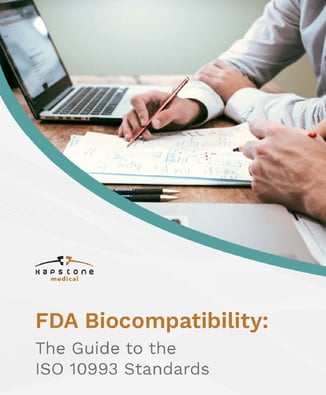ISO 13485 certification is a routine practice for medical device manufacturers. So much so, in fact, that sometimes over-familiarity with the standard can lead to knowledge gaps or misperceptions.
On the other hand, if a medical device manufacturer hasn’t experienced the certification process, there are common questions after the initial “how to get ISO 13485 certification” inquiry that need answers.
As a trusted medical device consultancy, Kapstone Medical has guided many manufacturers to and through ISO 13485. During the process, customers frequently ask for clarification on the 5 facts we’re addressing in this article.
What is ISO 13485?
ISO 13485 is an international standard that outlines requirements for a quality management system (QMS) specifically intended for medical device design, development, production, installation, and servicing. Medical device manufacturers must comply with ISO 13485 to ensure that their product quality is consistent, safe, and effective in protecting patients.
5 ISO 13485 facts that may surprise you
1. Certification is voluntary
While it’s widely held that ISO 13485 is mandatory for medical device manufacturers, the truth is that certification is voluntary. There is no requirement for OEMs to hold ISO 13485, but it does carry international clout. It is typically the fastest way for manufacturers to demonstrate continued device quality and compliance with requirements, as well as organizational commitment to quality. For suppliers, it’s often a key differentiator in winning business.
2. Certification is valid for 3 years, during which audits and surveillance occurs
A successful certification is valid for 3 years, but regulatory bodies remain active during that time. Alternating intervals of surveillance audits and recertification audits are conducted to ensure compliance is consistently maintained. Provided the company is in good standing at the end of the 3-year period and chooses to recertify, the entire cycle starts again, with a recertification audit of the entire QMS system.
3. The Medical Device Single Audit Program (MDSAP) satisfies audit requirements for participating regulatory authorities
MDSAP is an initiative undertaken by the US FDA, Health Canada, Therapeutic Goods Administration (Australia), Agência Nacional de Vigilância Sanitária (Brazil), and the Ministry of Health, Labour and Welfare/Pharmaceuticals and Medical Devices Agency (Japan). The goal is to streamline medical device manufacturer QMS audits and assessments, and standardize the approach to checking each country’s regulations and making the appropriate selections as to which countries are covered under MDSAP.
4. Supply chain vendors are not obligated to have ISO 13485 certification
Vendors in a medical device manufacturer’s supply chain are not required to be ISO 13485 certified, but it is generally sought after and an increasingly common OEM requirement. A manufacturer’s certification does not directly extend to their vendors, but the standard places great emphasis on OEMs controlling their supply chains to ensure partnerships that promote overall medical device quality and safety.
5. ISO 9001, ISO 13485, and EN ISO 13485 are not interchangeable
ISO 9001 addresses the quality management system standards for all industries. Focus of quality management under ISO 9001 includes customer needs, leadership, employee engagement, processes, continuous improvement, data-based decision making, and relationship management. ISO 13485 was born out of ISO 9001 and specifically concentrates on medical devices. EN ISO 13485 mirrors the global ISO standard in nearly every way, with caveats for alignment with the EU Medical Device Regulation (MDR).
All focus areas of ISO 9001 are incorporated into ISO 13485 and EN ISO 13485, along with medical device-specific processes and design controls, namely QMS management responsibility, resource management, product realization, complaints, and measurement/analysis requirements.
How Kapstone Helps Start-up and Established Medical Device OEMs
ISO 13485 is nuanced, which often leaves startups and established OEMs attempting to separate fact from fiction about obtaining or maintaining the voluntary certification.
Kapstone Medical is the go-to resource for manufacturers seeking QMS implementation, compliance to regulatory bodies, and ISO 13485 certification. Our well-rounded team of experts can connect with OEMs at any point in the process to answer questions, guide next steps, act as audit representatives, and/or shape QMS strategies to ensure ongoing regulatory compliance.
Partnering with Kapstone provides the single-source support needed to confidently meet ISO standards pertaining to all aspects of medical device quality, safety, and effectiveness. Discover how we apply our expertise and share our insights in our eBook, FDA Biocompatibility: The Guide to ISO 10993 Standards. Click the button below to download your copy.




